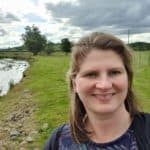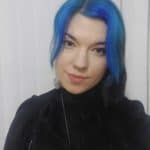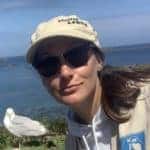Profile
Priscilla Tng
-
About Me:
I am a biologist working to protect pigs 🐷 from deadly viruses☠. I am originally from Singapore 🇸🇬 and have lived in Germany 🇩🇪 before moving to Hampshire 🇬🇧 with my husband and 3 children. In my spare time, I spend time with my family, watch movies and bake🧁. I also knit🧶, crochet and sew toys 🧸 and toy clothes.
-
Read more
How do white blood cells in pigs respond when they meet a harmful virus? How do they defend the pig and stop illness? These are the interesting questions that I try to answer with my research as a biologist to protect pigs from a deadly virus called African swine fever (don’t worry, African swine fever only infects pigs 🐷).
I am originally from Singapore and spent five years studying in Germany before relocating to Hampshire with my husband and 3 children. In my spare time, I spend time with my family, watch Disney, Star Wars or Marvel movies, build Lego or micro blocks, and bake goodies for my children. I also make many different crafts with my children, such as knitting, crochet, sewing and beading. Our current craft is shrink plastic! I am also learning how to code so that I can analyse my research data in more complex ways.
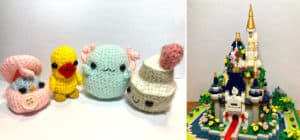
Some crochet toys I have made for my children and my latest micro block build.
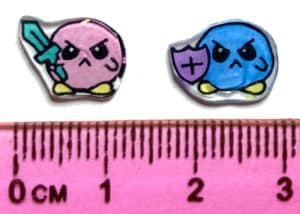
Our newest creations with shrink plastic. Tiny tokens for a new game!
-
My pronouns are:
she/her
-
My Work:
I am a biologist working to protect pigs from deadly viruses. I previously made mutant mosquitoes and worked on long-term storage of human blood products.
-
Read more
I have been a biologist for over 14 years and I have worked in different areas of biology. I have previously worked with human blood 🩸 and mosquitoes 🦟; I now work with pigs 🐖!
I am interested in how pig white blood cells protect pigs from viruses. To learn more about the different white blood cells in pigs, I label the different cells with different colours. I then look at the cells using flow cytometry. Flow cytometry is a special tool that helps scientists look closely at each cell 🔬 and sort the cells based on their colours 🔴 🔵 🟢 🟡 (similar to sorting different candies such as Snickers, Kit Kats, Maltesers and Twix into their different groups). This then allows me to find out which white blood cells change in their phenotype. Phenotype is something like the clothes or costume that cells wear. The clothes or outfit that cells wear shows what a cell looks like and how it behaves in the body. When white blood cells meet a virus, they will change their clothes or outfit and behave differently, so I am trying to understand how the white blood cells change and behave when they meet the African swine fever virus.
African swine fever virus is a tough illness that makes many pigs around the world very sick. It is important to understand more about this virus so that we can prevent pigs from catching this disease, to keep pigs safe and healthy. The information I find out can help us develop better vaccines 💉 for pigs.
A lot of the work that I do are with cell lines and I have to grow (or culture) these cells for my experiments. These are cells from pigs or other animals that have been made into mutants that can grow outside the body in plastic flasks with special liquid containing food for the cells. Many of these cell lines have been grown in different labs all over the world for many years! I can grow the African swine fever virus in some of these cell lines to study the virus.
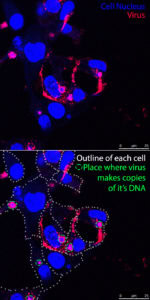
These are photos of mutant cells that can grow in plastic flasks. These cells have been infected with a DNA virus. The cell’s and the virus DNA are tagged in blue and the virus that is produced in the cell is tagged in red. The virus makes little virus factories outside of the cell’s nucleus where it copies itself to make more viruses!
Before working with pigs and their white blood cells, I worked with mosquitoes 🦟. I made mutant mosquitoes that were less able to transmit diseases. To identify the mutant mosquitoes, I inserted a marker gene that would make the mutant mosquitoes glow in blue, red, green or yellow under a special laser in the dark (these colours are normally invisible until the special laser is used in the dark).
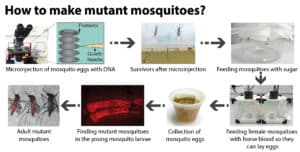
This is how mutant mosquitoes are made in the lab!
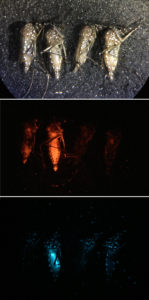
These are some mutant mosquitoes that have been tagged with different colours that are visible with special lasers in the dark.
Top: white light
Middle: green laser to see mosquitoes tagged in red
Bottom: blue laser to see mosquitoes tagged in blueI also used to work in the biomedical field to find a way to store human blood products 🩸 for a longer time using freezers ❄️. Blood and blood products are important to save lives and can be kept in a fridge for up to 42 days. Designing ways to store blood products in freezers will extend the storage time to years (some blood products have been stored for over ten years!), and this is very important for people with very rare blood types. I used in vitro (in vitro means in the lab and outside of a living body) methods to check the quality of the blood cells in my experiments to make sure they are of good quality and like the blood cells that are found inside our bodies.
-
My Typical Day:
I start working in the lab at 7 am, and what I do each day depends on my experiments. I either run experiments in a special clean cabinet called a biosafety cabinet to keep out germs, or I look at my results and write reports. Usually, I finish work around 4-5 pm, but if I have longer experiments, I keep working until 7 pm.
-
Read more
I am usually in the lab by 7am in the morning (to miss the traffic on the roads!). Each day can be very different depending on the experiments I have.
I work in a high containment laboratory because African swine fever virus is a harmful virus for pigs. In the high containment laboratory we have special procedures that must be followed and it is a safe and secure place where the viruses we work with cannot escape.
First, I check my emails to find any important tasks. Then, I look at my plan to see which experiments I need to do that day. I usually start with experiments that take a long time to finish, called incubation times. It’s like waiting for cookies or cakes to bake in the oven. This is similar to some parts of my experiments. If one experiment is waiting, I can work on another. Because I work with cells, I have to use a biosafety cabinet. It’s a very clean cabinet that keeps out bacteria and fungi so the cells can grow properly without any unwanted visitors.
After each experiment, I look at the results from my experiments. I use different computer programs and sit at my desk to figure things out. I also check if other scientists worldwide have found similar results in their experiments. I read their reports, also known as scientific publications, and compare what they found with my results. I write reports to share my discoveries with others, and that means a lot of writing and creating pictures.
In my job, I need to discover better ways to understand what’s happening with the cells I’m studying. This means I have to do new experiments. Before I start these new experiments, I read reports from other researchers to learn more. I try out their methods in small experiments first before doing bigger ones.
Most days, I finish my work by 4-5 pm, but on days with longer experiments, I might keep working until 7 pm.
-
What I'd do with the prize money:
I will use the money to create a game that teaches students how white blood cells fight viruses and keep the body safe. The game will also show students the tools biologists use to study these cells. This game can then be used at schools when researchers from my institute visit to share more about our work.
-
Education:
I went to secondary school and college in Singapore. In secondary school, I studied Physics, Chemistry, Music, Geography, and German. I could not take Biology because I did not qualify for triple science. In college, I chose Biology, Chemistry, Math, and German, and also did an S level in Biology. I then studied Biology at the University of Wuerzburg in Germany, where all my courses and many exams were in German. After working for a while, I moved to the UK and did my PhD in Biology while working at the Pirbright Institute, in partnership with the Royal Veterinary College.
-
Qualifications:
10 GCE ‘O’ Levels (this is similar to GCSEs). I did not qualify to do biology in secondary school, so I only did Physics and Chemistry.
4 A Levels, 2 AS Levels and 1 S Level. In college I did Biology A Level and S Level.
Masters in Biology (my biology course was in Germany)
PhD in Biology
-
Work History:
I began as a scientist in Singapore, working in a research institute for 6 years. After that, I moved to the UK and joined the Pirbright Institute, where I spent 5 years studying mosquitoes. During this time, I finished my PhD and got interested in immunology. So, I switched to a new research group focusing on African Swine Fever Vaccinology. I’ve been working in immunology for the last 3 years.
-
Current Job:
Now, I am a postdoctoral scientist in the African Swine Fever Vaccinology group at the Pirbright Institute.
-
Employer:
The Pirbright Institute is a research institute where scientists work together to study and understand diseases that can affect animals, especially farm animals. We try to find ways to keep these animals healthy and safe from illnesses.
-
My Interview
-
How would you describe yourself in 3 words?
Craft-loving immunologist
What did you want to be after you left school?
I always wanted to be a biologist!
Were you ever in trouble at school?
Of course! Nobody is perfect!
If you weren't doing this job, what would you choose instead?
I would probably be a craftsperson.
Who is your favourite singer or band?
I have quite a few and it changes often, but Dua Lipa and The Jonas Brothers are currently on my playlist.
What's your favourite food?
Cookies and sweet biscuits!
If you had 3 wishes for yourself what would they be? - be honest!
They would all be superpowers: (1) the ability to clone myself, (2) the ability to control time, and (3) speed thinking abilities.
Tell us a joke.
How do trees get onto computers?-----------They log on!
-


